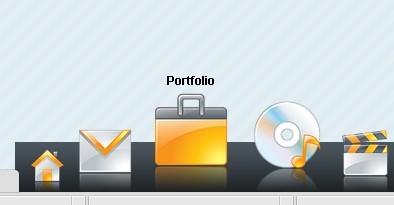
- Os dock with html and css install#
- Os dock with html and css full#
- Os dock with html and css code#
- Os dock with html and css download#
- Os dock with html and css windows#
Module to create native browser window.Ĭonst BrowserWindow = electron.BrowserWindow ĭatabaseFolder : app.getPath("documents") The content of this file is pretty much the same as found on the Quick start guide available at the. It initializes the bare chromium browser window and determines what to do when certain thing concerning that window are happening – like minimizing / maximizing and closing the window.
Os dock with html and css code#
The main.js file is a JavaScript file containing the bootstrap code for initializing the main process of the desktop application. If you look closely to the start configuration and next to your project folder, you might notice that one file is missing – main.js. So now everything is almost setup to run our JavaScript SPA as a desktop application. If we want the electron runtime to boot up when we issue the npm start command, we need to change the scripts / start option manually to electron main.js as mentioned in step 3.

Since we’re not using the lite-server anymore, we could either remove the lite-server dev-dependency manually from the package.json file or we could issue the command: C:\Src\App1>npm remove lite-server –save-dev
Os dock with html and css install#
The npm install only caused step 1 to be added to the package.json file because of the –save option.

Os dock with html and css download#
This will download the Electron package and stores the dependency in our package.json file so it will look like this: This is done by entering the following command: C:\Src\App1>npm install electron-prebuilt –save So, let’s turn this into a Desktop app by adding the Electron package to the project. Let’s hit Ctrl+C in our terminal window to exit the lite-server. We will not be using this since we’re going to create a desktop app. This feature monitors the source folder for changed files and automatically refreshes the browser used for testing. It has a couple of convenient features like browser-sync. It is specified as dev-dependency in the package.json, so it was downloaded and configured during our npm install command. It is written in Node by John Papa and Christopher Martin. Lite-server is a small web-server – much like IIS Express for ASP.NET development – to test SPA web-based apps. The package.json will be checked for the scripts / start setting which will execute the lite-server and show a browser with our SPA (Single Page Application). Now, we can start the project in our browser by issuing the command: C:\Src\App1>npm start This project will not use Angular, Globalize or Webpack. In our case it comes with a couple of warnings which we can safely ignore. This is done by the following command: C:\Src\App1>npm installĪfter some time – depending on your internet speed – NPM finishes. This is because we will use NPM to get all dependencies for this project.īecause we made a fresh clone, we need to get all those dependencies through NPM. One thing which is slightly different, is the lack of JavaScript files in the /js folder and the references in the index.html.
Os dock with html and css full#
If you’re used to the full Visual Studio experience and have used the project template which comes with DevExtreme, you might recognize the folder structure as well as several files provided with this clone. change the application name and version number. The package.json already includes the required NPM packages but if you’re new to NPM, it might be worth taking a look at it. Once the cloning is finished, we can start VSCode like: C:\Src\App1>code.

The repo can be found at:, and we can clone it to our App1 folder with the following command at the command prompt: C:\Src\App1>git clone.
Os dock with html and css windows#
Make sure you use some short folder structure like C:\Src\App1, since the MAX_PATH value in Windows is reached fairly quickly when using NPM and node modules! C:\cd \Srcīecause Visual Studio Code doesn’t support Project templates out of the box, I decided to use a GitHub repo as project template by cloning it. With these tools setup, you can fire up a command prompt and create a folder which will hold the project and navigate into it. Prerequisitesīefore opening a command prompt, make sure you have the latest versions installed of the following: In case you have heard the term NPM, but don’t know exactly what it is NPM is for Node what Nuget is for dotNet.įor all of you wanting to redo the demo project on your own – a simple ToDo app – I have written down the steps that where performed in the webinar. This was also one of the first webinars where a swift introduction on DevExtreme with Visual Studio Code, Git, Node/NPM (Node Package Manager) and the Command-Line was performed. In case you missed it, it is available on our YouTube Channel Last week I did a webinar on creating desktop applications with DevExtreme and Electron.


 0 kommentar(er)
0 kommentar(er)
